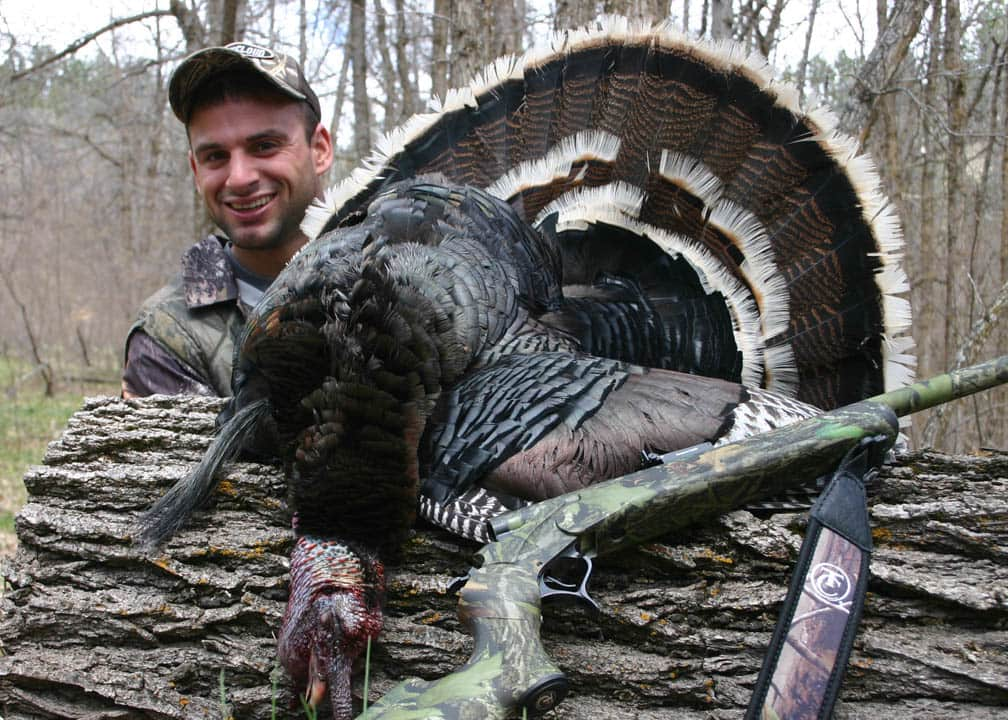It’s Time to Set Your Sights on Spring Turkey Hunting
Bill Miller 01.18.15

It’s later than you think! Now that we’re on the downhill side of January, it’s time to start getting ready for turkey hunting. For those lucky enough to have hunts planned in the Deep South, opening day is just a couple months away. If you’re looking at a new rig for turkey hunting or modifying Ol’ Bessy to take full advantage of the best new shotshells, now’s the time to get after it! Research, acquisition, testing with time to make changes—come to think of it, we may already be running late, especially if you’re going to add sights to your turkey hunting shotgun.
The thrill in turkey hunting is bringing a wary old tom in close—the closer the better as far as I’m concerned. The ultimate victory would be to pull him into your lap where you wouldn’t have to shoot him at all and you could just reach out and grab him!
 When you pull a strutting tom so close you can feel the vibration of his drumming through your whole body, then you know you’ve done everything right as a hunter. Your calling was good. You were perfectly camouflaged to avoid detection. And most importantly, you avoided the temptation to move or even blink. You were, at least at that moment, the ultimate predator.
When you pull a strutting tom so close you can feel the vibration of his drumming through your whole body, then you know you’ve done everything right as a hunter. Your calling was good. You were perfectly camouflaged to avoid detection. And most importantly, you avoided the temptation to move or even blink. You were, at least at that moment, the ultimate predator.
While totally fooling the bird is the thrill of turkey hunting, it just wouldn’t be the same without the opportunity to finish the deal; to make the shot and claim your prize—along with delicious dining for you and your family. Fresh, wild turkey breast on the grill alongside some wild ramps or morel mushrooms is the greatest spring tonic on the face of the Earth. So, for a lot of reasons, you do not want to miss.
It’s true that if you haven’t missed a turkey, you haven’t hunted them very much. But the secret you don’t hear very often is that it’s easier to miss a turkey in close than it is to miss one 20, 30, or 40 yards out. Each season brings new technology in shotshells and shotguns to make shot patterns shoot ever-tighter. Gone is any margin for error that used to exist for shots at less than 10 yards.
At these super-close ranges, your shotgun is performing more like a rifle than a scattergun. At 10 yards and in, you’re dealing with a “pattern” less than three inches across. Out at 40 yards it has expanded to at least 24 inches in diameter and it’s probably just as deep (that’s why they call it a “shot string”). Think of it like this: at five to 10 yards you’re trying to hit a tom’s head with a golf ball or tennis ball. At 25 yards you’ve got a soccer ball to do it with. So you have way more margin for misalignment at 40 yards than you do at 10.
The answer for accurate shooting at turkeys is the same for both ranges, but it’s actually more important up close than it is far out—put sights on your turkey gun!
 Any kind of adjustable sighting system will do. Here’s three options:
Any kind of adjustable sighting system will do. Here’s three options:
Iron sights or peeps are great. There are other good open sight options specifically designed for turkeys, too.
A red dot or reflex sight is a smart choice.
Scopes (especially ones built for turkey hunting) are also great, but be careful. Heavy turkey loads are notorious for slap-you-in-the-head kind of recoil. If you creep up on the scope in the excitement of having a turkey in your lap, you’re going to end up with at least a nasty headache, and might need a bunch of stitches.
The key to sights on a turkey gun is adjustability. You must sight-in your turkey shotgun just like you do a rifle, but after you have the pattern centering nicely at 20 or 30 yards, you’ll do the precision adjustments at 10 yards or less. That’s just the opposite of sighting in a rifle, where you do the fine work at greater distances.
Shoot a few of your chosen loads at seven or eight yards, and you’ll quickly see why it’s so important. If your aim is off just a fraction with a pattern the size of a golf ball, you miss! And that’s what we are trying to avoid.
 Tip of the Week
Tip of the Week
Whenever, wherever there’s turkey hunting going on, the mosquitos are certainly not far behind. Set your sights on total comfort and protection from mosquitos when you’re turkey hunting this spring. Chances are you already have a ThermaCELL in the pocket of your turkey hunting vest. Just make sure you have an ample supply of repellant pads and butane cylinders to go along with it. You’re going to need them.
These insights brought to you by Federal Premium Ammunition, ThermaCELL, Camp Chef, and the Quebec Outfitters Federation.



